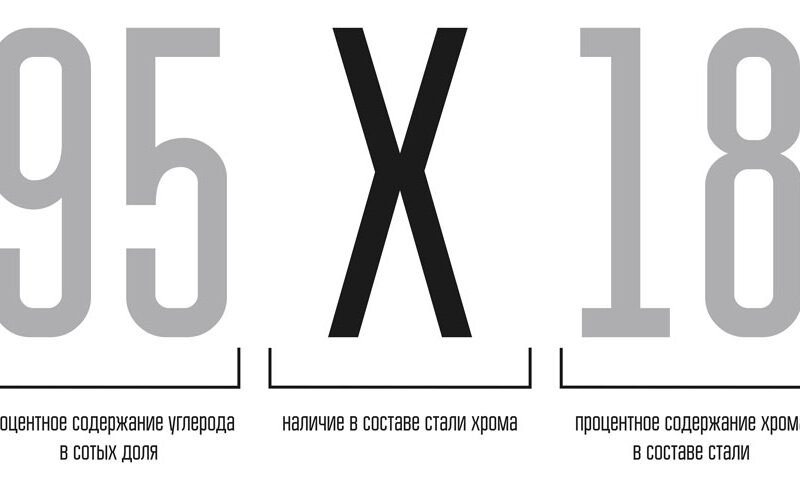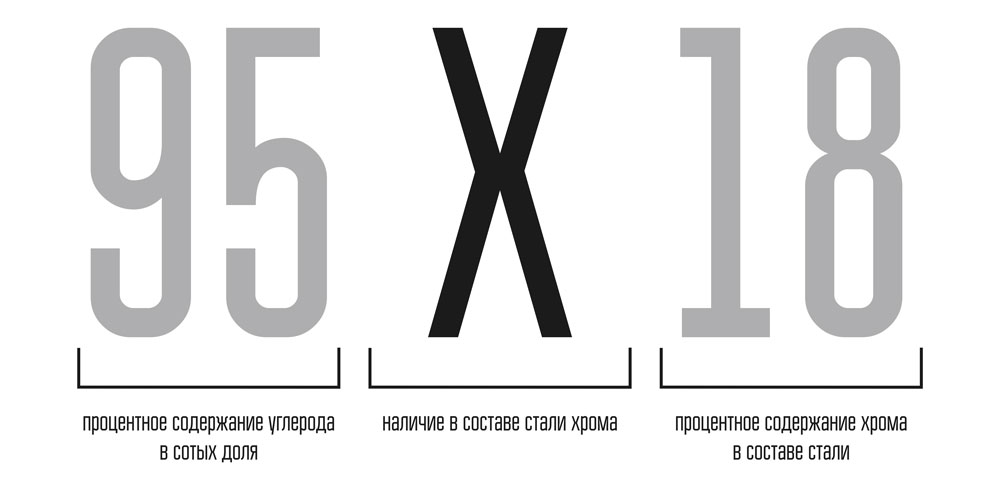
Areas of application of steel 95x18: technical characteristics of training and reviews
Steel is the main metal, used for the manufacture of machines, aircraft, devices, building elements, tools and weapons. Such application in various industries becomes possible due to a complex combination of technological, mechanical properties and chemical properties.

Many types of steel are produced, each of them differs in its positive and negative characteristics. When buying a steel product, you should correctly decide on the choice of metal, used for manufacturing, that the subject served long time.
The product is characterized by different geometric shapes, but to a greater extent its qualities depend on the structure and composition of the metal, determined by the produced heat, mechanical and chemical treatment. The combination of these qualities allows to obtain such a variety of metals and steel grades. For the production of metal objects and elements, there are various established strength priorities, plasticity, viscosity. Initially, the steel is selected by chemical composition, and then with the help of heat treatment it is given the necessary properties.
Сталь 95х18
This type of steel in terms of hardness and strength is used, as a basis for the implementation of various elements and details. These can be bearings, axial structures, bushings, but differ in the best quality, made of this steel, knives.
Steel 95x18 is the best option for the production of such items. Invented a chemical composition with effective properties not so long ago, but the growing popularity of the material speaks of its high performance. Production of elements from this type of steel is organized on a professional basis, as to work with it the exact equipment is required and steelmakers know the business. The material is capricious, at the slightest deviation from the technology is overspending or untimely vacation. Only an enterprise can afford to produce 95x18 steel objects, is constantly engaged in the manufacture of such items and gain considerable experience in this field.
The composition of chemical elements
Chemical components became present in the composition, which affect the effectiveness of indicators:
- silicon and magnesium no more 0,8%;
- copper to 0,3%;
- phosphorus and sulfur no more 0,026-0,031%;
- manganese to 0,6%;
- nickel is contained no more 0,6%;
- titanium do 0,2%;
- chrome is from 17 to 19%.
The high content of chromium in the composition of steels 95x18 allows them to resist corrosion and not rust. Metal is a great example for forging, the procedure of which rids the material of microcracks, reduces the content of oxygen and hydrogen in the pores. Forging makes the molecular structure more densely complete atoms and removes all empty cavities in the crystal lattice. This treatment of steel increases ductility, as the grain of the metal decreases, but the strength remains the same.
Форма виробу
The constructional shape of the product plays a significant role, which distributes the load and increases functionality. The shape of the blade distributes the load correctly, and the use of a knife becomes easy and convenient. Designers are also working on the shape of any element of production value, allowing you to choose the most effective combination of indicators and shape of the subject.
Working with metal is a vocation, саме тому виготовлена по ГОСТу сталь 95х18 знайшла покликання не лише на території Росії, it is a serious competition to many steels of foreign manufacturers.
Interaction of steel with various components
The high content of chromium in the chemical composition makes steel 95x18 invulnerable to corrosion and rust, but there are some rules of use:
- mechanical loads must be used only for their intended purpose, improper use of objects destroys the edge and creates a curvature of the blade;
- despite corrosion resistance, prolonged stay in saline may adversely affect surface integrity, which will lead to deterioration of operational qualities;
- constant and prolonged stay in a humid environment will reduce the functionality of the product.
Main indicators and properties
The material belongs to the class of corrosion-resistant steels, used for the manufacture of responsible durable parts, to which the requirements of the increased resistance to wear and work under the influence of moderate aggressive influence in the temperature mode, elevated to 500 ° C. On an industrial scale it is delivered in the form of high-quality hire, shaped, calibrated and polished rod, silversmiths, stripes, forgings and forged blanks.
Механічні показники
Steel, when properly processed, acquires the properties of strength and flexibility, but improper tempering and untimely vacation will add constant negative parameters. Steel is not so easy to sharpen on a machine, but with proper handling the knife will be sharp for a long time. Processing parameters:
for hardening oil is used at a temperature in the range 1000-1050? WITH;
- vacation is air or oil at room temperature 200-300 ° C;
- complete annealing of the rod is done at 885-920 ° C;
- incomplete annealing is carried out at 730-790 ° C;
- heating is performed at 850-860 ° C;
- cold treatment is performed when 70-80 ° C.
Технологічні характеристики
For the manufacture of strip and high-grade steel used rolling or forging of the original workpiece at high temperature, followed by slow cooling:
- the beginning of the forging temperature is carried out at 1190? WITH, ending occurs at 840 ° C, subsequently maintained at 750 ° C, then cooling;
- profile section to 700 mm is annealed with recrystallization and subsequent tempering;
- steel 95x18 is not used for the manufacture of structures, which are subsequently subject to welding;
- the proportion of steel is 7740 kg per cubic meter;
- hardness of the material 230-240 MPa.
steel division
Steels have high rigidity combined with static strength. By changing the percentage of carbon, alloying elements and heat treatment conditions, these figures can be increased or decreased in a wide range. Such experiments allow to diversify the chemical composition, change the properties and apply the obtained materials in various fields of industry and economy.
Become, enriched with carbon is divided by its percentage:
- low carbon, with less content 0,31%;
- medium carbon - in the composition 0,31-0,75%;
- high carbon, with more content 0,75% carbon.
According to the purpose of use, there are structural and tool steels. The first numerous group includes metals, used in construction, for the manufacture of parts of mechanisms, devices. From the materials of the second group make measuring precision and cutting tools, produce stamps of hot and cold processing.
Given the quality indicator, steel is divided into ordinary, high quality and high quality. This characteristic is determined by the properties obtained in metallurgical production. Carbon steels are conventional materials, alloyed (enriched with carbon) attributed to high quality materials.
steel production
Steel is made of cast iron or pig iron, iron-containing materials and products, obtained by recovery. Use metal waste and scrap. Additives are added to them to form slag, example, lime, shpat, deoxidizers are used (aluminum, ferromarganese), add alloying materials.
Steel production is divided into two ways - converter and hearth processes. The first involves refining cast iron from impurities by blowing it with oxygen. Such technologies do not require the use of an external heat source, because molten cast iron, containing oxides (phosphorus, carbon, manganese and silicon) able to provide the required amount of heat to keep the steel in a liquid state.
The hearth process takes place inside blast furnaces or electric furnaces, require an additional heat source from the outside. They are used for remelting solid metal scrap and charge. At this stage, the open-hearth process becomes the main one, requiring the combustion of liquid heat carriers, solid or gaseous type. Then melted ??steel is poured into a ladle. This time is used for enrichment with alloying additives.
Oxygen-converter method of melting
This method consists in the removal of carbon and pig iron impurities by oxidation by purging with oxygen in convector smelters. The capacity of such a furnace in 50-60 T, it is shaped like a pear and rotates around the axis. From the lining of the furnace converter method is divided into Bessemer and Thomas.
The Bessemer method is used for smelting cast iron with a high percentage of silicon. During purging, silicon is oxidized and emits a significant amount of heat. Burnout of almost all silicon raises the temperature to 1500-1600 ° C, this begins the burning of carbon, iron is oxidized in parallel. The resulting iron oxide dissolves well in cast iron and turns into steel. Phosphorus also becomes part of steels, which after bottling usually contains less 0,21% carbon and are used for technical purposes. They make bolts, nails, wire and iron for the roof.
Thomas method is designed for processing cast iron with phosphorus in its composition. The lining of the furnace is made of oxides of calcium and magnesium. So, slag-forming substances contain a significant amount of oxides with basic properties. The resulting phosphate anhydrite reacts with excess calcium and turns into slag deposits. The main source of heat is the combustion of phosphorus.
Bessemer and Thomas methods allow to obtain steel with low carbon content, apply them to high-tech parts and components is not recommended.
Open-hearth furnace for steel production
Differs from the converter theme, that burning contributes not only to air oxygen, but also oxygen, obtained from iron oxides, which enter the furnace as a part of iron ore or pink scrap metal.
The open-hearth furnace is preheated air and combustible gas. With the help of a system of regenerators there is an alternate movement of fuel gas alternately in two directions. The combustion of carbon and impurities in the first stage occurs after the combustion of oxygen and combustible mixture. Due to the combined action of acidic and basic oxides, sulfur is released, silicates and phosphates, passing into slag. Before the end of melting stop pouring slag, and add deoxidizers, which allow to obtain high-carbon steel, obtained by the subsequent use of alloying additives.




